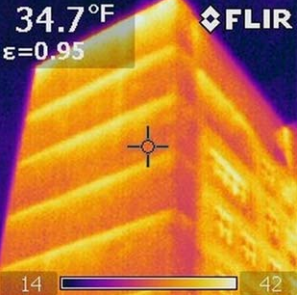Why Steel
Thermal Performance
Properly designed structural steel framing systems can reduce building energy consumption
The proper selection and design of a framing system can directly impact the thermal performance of the building. Minimizing thermal bridging and optimizing thermal capacity can both be achieved through the use of a properly designed structural steel framing system. Thermal Bridging
Thermal Bridging
Thermal bridging refers to the loss of building energy through thermal conductivity of elements that "bridge" across the insulation of a wall or roof enclosure of a conditioned (i.e., heated or cooled) space when the outside temperature is warmer or colder than the interior space.
Reducing energy usage in buildings has become one of the most widespread goals in the construction industry. Efforts to reduce building energy use are typically focused on the mechanical, electrical and glazing systems and not the structural system. However, one area where structural designers can reduce energy consumption is thermal bridging. While all structural framing materials contribute to thermal bridging, AISC, in partnership with the SEI Sustainability Committee developed strategies, solutions and improved details to address thermal bridging specific to steel members.
This project investigated various common detailing practices to determine if alternate solutions could be both cost effective and more thermally efficient with improvements to traditional construction methods.
Recommendations
- Minimize conditions of continuous thermal bridging, such as at continuously supported steel brick shelves. Read here for explicit examples, similar to the one shown at the right, of detailing improvements.
- Pay particular attention to minimizing thermal bridging for buildings that fall into one or more of the following categories:
- Buildings with a long estimated service life, such as institutional buildings, hospitals, etc.
- Buildings in extremely warm or cold climates
- Buildings where highly climate-controlled conditions exist, such as medical facilities and senior residence facilities
- Consider the use of two-dimensional heat transfer modeling software to analyze unusual conditions where thermal bridging may occur in conditioned buildings.
- Discuss the issue of building envelope energy performance with the other members of the design team, in order to develop coordinated strategies to minimize building energy loss through thermal bridging.
- Confirm the structural integrity of any design solution for the project under design.
- For informational purposes, take advantage of any opportunity to obtain feedback of the building envelope energy loss of buildings you have designed, using an infrared thermal camera.
- Perform a full ROI analysis of proposed details before preparing construction doc.
Thermal Capacity (sometimes erroneously referred to as thermal capacity)
Thermal capacity is the ability of a material to absorb, store, and release heat. It is measure d in the number of Joules of thermal energy stored per unit of capacity (J/kgK), or per cubic foot of material (J/ m3 K). The basic principle of using heavy structural elements, such as masonry walls, as sinks to absorb heat during the occupied period of the day is an age-old strategy for vernacular green designs.
d in the number of Joules of thermal energy stored per unit of capacity (J/kgK), or per cubic foot of material (J/ m3 K). The basic principle of using heavy structural elements, such as masonry walls, as sinks to absorb heat during the occupied period of the day is an age-old strategy for vernacular green designs.
Building designers are becoming increasingly interested in using thermal capacity to reduce heating and cooling loads in buildings. Doing so can lead to significant benefits in both energy efficiency and comfort. There is a common belief that heavyweight buildings are more effective than lightweight alternatives in achieving optimum levels of thermal capacity for cooling. However, the main reason that such buildings remain cool has nothing to do with their heavyweight construction. It is because they have relatively few windows, which reduces solar gain, and are usually lightly populated, which reduces internal gains.
Ryerson University in Toronto, Canada carried out a comparison of two types of structural systems used in a typical five-story office building. The study compared the modeled energy use of a steel-framed office building with a typical composite steel and concrete floor slab, to the same building using a cast-in-place concrete structure. In comparison, the two buildings performed almost identically, which suggests that the steel-framed office building has sufficient thermal capacity to generate the same benefits in energy use as the concrete building. Furthermore, it is clear that the glazing-to-wall ratio is a far more significant factor affecting predicted energy use.
Resources
Steel Solutions Center
The Steel Solutions Center is for people who need technical assistance, innovative solutions, or tools to make structural steel design even easier.
